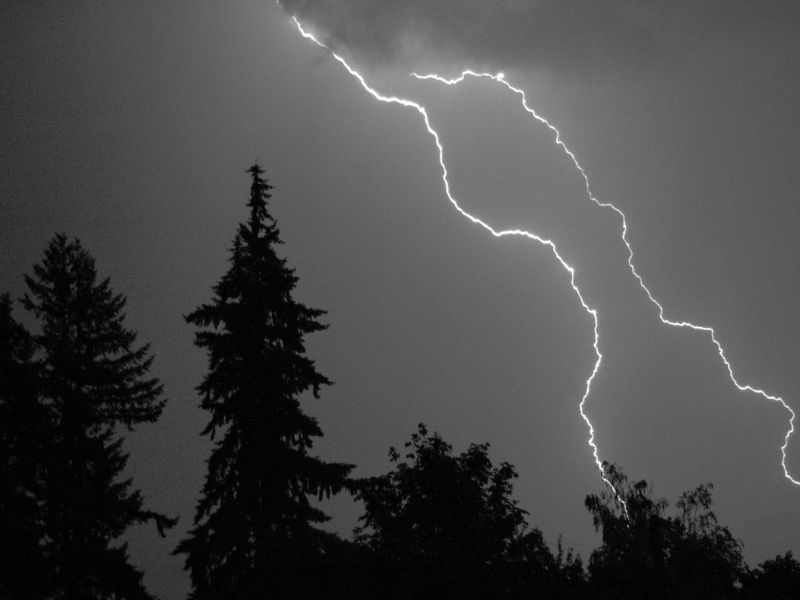Lightning storm prediction combines meteorological forecasting with real-time prediction systems to provide advanced warning of dangerous conditions. While individual lightning strikes cannot be predicted due to their random and widespread nature, Thor Guard’s lightning prediction technology can monitor storm electrification and forecast lightning activity—giving businesses critical time to protect people and operations.
Understanding the difference between weather forecasts and dedicated lightning prediction systems is essential for any organization with outdoor operations.
The Science Behind Lightning Storm Prediction
Most meteorologists use two primary methods to assess lightning threats: observing current weather conditions and running computer forecast models.
Current weather observation focuses on near-term predictions within the next hour. Scientists analyze whether a storm has produced lightning before, if it’s growing in size, whether it reaches freezing altitudes, and how it’s moving. By comparing these characteristics to historical data, forecasters create probabilistic predictions of where storms might produce lightning.
Computer forecast models predict lightning activity beyond one hour. While directly simulating lightning behavior remains computationally expensive, meteorologists use existing weather models to analyze storm features. They examine storm size, ice and water droplet content, charge-carrying ice particles, and updraft velocity. Statistical relationships between these factors enable probability-based lightning forecasts well into the future.
Both methods share a critical limitation: they provide regional outlooks, not site-specific warnings needed for immediate safety decisions.
Why Weather Forecasts Aren’t Enough for Lightning Safety
NOAA’s Storm Prediction Center and local National Weather Service offices provide valuable thunderstorm forecasts ranging from hours to days in advance. These forecasts help with strategic planning—scheduling events, allocating resources, and preparing safety protocols.
However, weather forecasts cannot:
- Provide site-specific strike warnings at your exact location
- Offer minute-by-minute threat updates as conditions change
- Automatically trigger safety protocols and evacuation procedures
- Give advance warning before the first strike occurs at your facility
- Replace the need for real-time atmospheric monitoring
This creates a dangerous gap for businesses operating outdoor facilities. A regional thunderstorm forecast for “this afternoon” doesn’t tell you when to evacuate your golf course, construction site, or athletic field. By the time weather warnings are issued, lightning may already be striking your location.
How Professional Lightning Prediction Systems Fill the Gap
Unlike meteorological forecasts that cover broad regions, Thor Guard Lightning prediction systems provide localized, real-time protection through electrostatic field monitoring technology.
These systems continuously measure atmospheric electrical changes at your specific location, detecting storm electrification and charge buildup before strikes occur. The world’s only true lightning prediction technology identifies when conditions are becoming dangerous, typically providing 8-20 minutes of advance warning—critical time for safe evacuation.
Detection vs Prediction: Understanding the Difference
Lightning detection systems track strikes after they occur, providing a delayed and questionably accurate location and distance data that is really only somewhat useful for post-event analysis. A lightning prediction system from Thor Guard will monitor pre-strike atmospheric conditions up to 170,000 per second, offering proactive warnings before lightning threatens your area.
For safety purposes, prediction capability matters most. Knowing lightning struck two miles away helps with analysis, but Thor Guard Lightning Prediction Systems allow you to know when dangerous conditions are developing before the first strike enables life-saving evacuation decisions.
Who Needs Lightning A Detection and Prediction System?
Any facility where people gather outdoors faces lightning risk and potential liability:
Outdoor Recreation: Golf courses, sports complexes, swimming pools, theme parks, summer camps, and marinas require rapid response to changing conditions.
Educational Institutions: Schools, universities, and athletic programs have duty-of-care obligations to protect students and staff during outdoor activities.
Industrial Operations: Construction sites, oil and gas facilities, mining operations, airports, and manufacturing facilities with outdoor components face both safety risks and operational disruptions.
OSHA lightning safety requirements, insurance mandates, and liability concerns make professional detection systems essential for risk management and compliance.
Key Features of Commercial Lightning Prediction Systems
Professional systems offer capabilities far beyond consumer weather apps:
Advanced Warning Times: Pre-strike detection provides minutes of lead time plus all-clear signals when threats pass, enabling complete evacuation and return protocols.
Automated Alert Delivery: Multi-channel notifications including visual strobes, audible horns, text messages, emails, app alerts and golf cart integration ensure everyone receives warnings immediately.
Localized Monitoring: Site-specific detection with customizable threat zones provides geographic precision tailored to your facility’s layout and operations.
Reliability: Weather-resistant equipment, backup power systems, and 24/7/365 continuous monitoring deliver dependable performance with minimal false alarms through professional installation and maintenance.
Documentation: Event logging, compliance reporting, and historical tracking provide essential data for incident analysis, risk assessment, and regulatory requirements.
The Business Case for Lightning Prediction
Lightning incidents carry substantial costs beyond immediate injury and property damage. Legal liability, insurance claims, premium increases, event cancellations, operational downtime, and reputation damage can devastate organizations.
Real statistics underscore the risk: lightning causes dozens of fatalities and hundreds of injuries annually in the United States, along with billions in property damage. Legal precedents show significant settlements when organizations fail to implement adequate lightning safety measures.
Investing in a Thor Guard Lightning Prediction system delivers measurable ROI through avoided liability claims, reduced insurance costs, operational continuity, enhanced reputation, regulatory compliance, and—most importantly—protected lives.
Protect Your Facility with Advanced Lightning Prediction
Don’t leave lightning safety to chance or rely solely on regional weather forecasts. A Thor Guard Lightning Prediction system provides the real-time, site-specific protection your organization needs.
Thor Guard specializes in comprehensive lightning prediction and detection solutions for facilities across industries. Our advanced systems deliver reliable advance warnings, automated alerts, and complete documentation to protect your people, operations, and organization.
Contact Thor Guard today for a free lightning risk assessment and discover how our proven technology can enhance your safety program. Visit our website or call to speak with a lightning safety specialist about customized solutions for your facility.
Your people’s safety is too important to leave to general weather forecasts alone.



